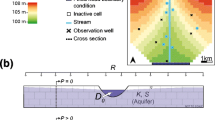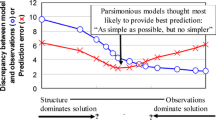Abstract
This paper describes the development of a methodology that can be used for determining the spatial and temporal distribution of additional water volumes required to meet a defined groundwater target, such as an historical peizometric surface. The methodology is demonstrated on a case study concerned with mitigating declining groundwater levels in an alluvial aquifer intensively used for agriculture in the Lockyer Valley, Queensland, Australia. The proposed mitigation measure is the importing of large volumes of purified recycled water (PRW) from a large scale indirect potable reuse scheme into the aquifer system. The developed methodology employs both a groundwater flow model together with linear uncertainty analysis. Therefore for the case study, a distributed parameter numerical groundwater flow model was developed for the Lockyer valley alluvial aquifer system using MODFLOW, calibrated to observed groundwater levels, and further constrained by estimates of diffuse and river recharge from water balance studies. The model was used to simulate groundwater levels in the aquifer over a 20-year period. Optimal spatial and temporal distribution of volumes of imported water required to mitigate declining groundwater levels over that period were then estimated, using a modified version of the MODFLOW General Head Boundary (GHB) package. Uncertainty in the predicted import volumes was estimated using linear bayesian analysis principles. The relative worth of data from each observation bore within the groundwater monitoring network was also assessed in terms of the extent to which predictions of import water volumes were made more reliable when furnished with that data. Application of the methodology to the Lockyer alluvial aquifer system illustrated the suitability of the developed methodology for estimating the additional water volumes required for managed aquifer recharge or groundwater substitution schemes in similarly over-exploited aquifers.








Similar content being viewed by others

References
Al-Salamah IS, Ghazaw YM, Ghumman AR (2011) Groundwater modeling of Saq Aquifer Buraydah Al Qassim for better water management strategies. Environ Monit Assess 173(1–4):851–860
Bejranonda W, Koch M, Koontanakulvong S (2013) Surface water and groundwater dynamic interaction models as guiding tools for optimal conjunctive water use policies in the central plain of Thailand. Environ Earth Sci 70(5):2079–2086
Bleakley A (2011) Changing groundwater storage in the central lockyer. Department of natural resources and mines. Queensland Government, Brisbane
Bleakley A, Boreel S (2012) Tenthill volumes determination. Department of natural resources and mines. Queensland Government, Brisbane
Cao G, Zheng C, Scanlon BR, Liu J, Li W (2013) Use of flow modeling to assess sustainability of groundwater resources in the North China Plain. Water Resour Res 49(1):159–175
Christensen S, Doherty J (2008) Predictive error dependencies when using pilot points and singular value decomposition in groundwater model calibration. Adv Water Resour 31(4):674–700
Christodoulou G, Dokou Z, Tzoraki O, Gaganis P, Karatzas G (2013) Attenuation capacity of a coastal aquifer under managed recharge by reclaimed wastewater. Paphos, Cyprus. 1st International Conference on Remote Sensing and Geoinformation of the Environment (RSCy)
Dausman AM, Doherty J, Langevin CD, Sukop MC (2010) Quantifying data worth toward reducing predictive uncertainty. Ground Water 48(5):729–740
Department of Land and Water Conservation (1996) Integrated Quantity-Quality Model (IQQM) user manual. NSW Department of Land and Water Conservation, Sydney
Doherty J (2012) PEST: model-independent parameter estimation. Watermark Numerical Computing, Brisbane
Ellis T, Hartcher M, Shreevatsa K, Henderson C, Wolf L (2013) Mapping crops from satellite imagery In: Wolf L (Ed.) Implications of using purified recycled water as an adjunct to groundwater resources for irrigation in the Lockyer Valley. Urban Water Security Research Alliance Technical Report No. 103, p. 95–112
Engelhardt I, Prommer H, Moore C, Schulz M, Schueth C, Ternes TA (2013) Suitability of temperature, hydraulic heads, and acesulfame to quantify wastewater-related fluxes in the hyporheic and riparian zone. Water Resour Res 49(1):426–440
Feng S, Huo Z, Kang S, Tang Z, Wang F (2011) Groundwater simulation using a numerical model under different water resources management scenarios in an arid region of China. Environ Earth Sci 62(5):961–971
Grimm M, Ellis T, Hartcher M, Hodgen M, Wolf L (2013) Mapping large scale water use changes and groundwater recharge in the Lockyer valley. In: Wolf L (Ed.) Implications of using purified recycled water as an adjunct to groundwater resources for irrigation in the Lockyer valley. Urban Water Security Research Alliance Technical Report No. 103, p. 144–151
Hadded R, Nouiri I, Alshihabi O, Massmann J, Huber M, Laghouane A, Yahiaoui H, Tarhouni J (2013) A decision support system to manage the groundwater of the zeuss koutine aquifer using the WEAP-MODFLOW framework. Water Resour Manag 27(7):1981–2000
KBR (2003) Lockyer valley hydrological consultancy. Final report prepared for Brisbane City Council. Kellogg Brown and Root, Brisbane
Koch KR (1987) Parameter estimation and hypothesis testing in linear models. Springere-Verlag, Berlin, Germany
Manghi F, Williams D, Safely J, Hamdi MR (2012) Groundwater flow modeling of the arlington basin to evaluate management strategies for expansion of the arlington desalter water production. Water Resour Manag 26(1):21–41
Moore C, Doherty J (2005) Role of the calibration process in reducing model predictive error. Water Resour Res 41(5)
Moore CR, Woehling T, Wolf L (2011) Optimisation of monitoring data for increased predictive reliability of regional water allocation models. 19th International congress on modelling and simulation (Modsim2011): 3903–3909
Powell B, Loi J, Christianos NG (2002) Soils and land suitability of the lockyer valley alluvial plains, SEQ. Land Resources Bulletin, Department of Natural Resources and Mines Report QNRM01215. Queensland Government, Brisbane
Rattray DJ, Freebairn DM, McClymont D, Silburn DM, Owens J, Robinson B (2004) HowLeaky? The journey to demystifying simple technology. Conserving soil and water for society: 13th International Soil Conservation Organisation Conference (ISCO). Brisbane
Sreekanth J, Datta B (2011) ‘Coupled simulation-optimization model for coastal aquifer management using genetic programming-based ensemble surrogate models and multiple-realization optimization’, Water Resour Res, vol. 47 Issue 4. doi:10.1029/2010WR009683
Sreekanth J, Datta B (2013) Design of an optimal compliance monitoring network and feedback information for adaptive management of saltwater intrusion in coastal aquifers. J Water Resour Plan Manag. doi:10.1061/(ASCE)WR.1943-5452.0000406
Sreekanth J, Datta B (2014) Stochastic and robust multi-objective optimal management of pumping from coastal aquifers under parameter uncertainty. Water Resour Manag 28(7):2005–2019
Traves WH, Gardner EA, Dennien B, Spiller D (2008) Towards indirect potable reuse in South East Queensland. Water Sci Technol 58(1):153–161
Wolf L (Ed.) (2013) Implications of using purified recycled water as an adjunct to groundwater resources for irrigation in the Lockyer valley. Urban Water Security Research Alliance Technical Report No. 103, 238 p
Yenigul NB, Elfeki AMM, van den Akker C, Dekking FM (2013) Optimizing groundwater monitoring systems for landfills with random leaks under heterogeneous subsurface conditions. Hydrogeol J 21(8):1761–1772
Conflict of Interest
No conflict of interest
Author information
Authors and Affiliations
Corresponding author
Rights and permissions
About this article
Cite this article
Sreekanth, J., Moore, C. & Wolf, L. Estimation of Optimal Groundwater Substitution Volumes Using a Distributed Parameter Groundwater Model and Prediction Uncertainty Analysis. Water Resour Manage 29, 3663–3679 (2015). https://doi.org/10.1007/s11269-015-1022-y
Received:
Accepted:
Published:
Issue Date:
DOI: https://doi.org/10.1007/s11269-015-1022-y



